With soot still on its hands from the Dieselgate scandal, Volkswagen is trying hard to wash it away by fully embracing an all-electric future. While its ID.3 hatchback was the first to make it into production in other markets, here in the USA, the model spearheading the charge is the new 2021 Volkswagen ID.4, a compact crossover. In some ways, it plays it safe: it's sensibly sized and shaped, with sufficient power and range. Compact crossovers are wildly popular and the ID.4 largely satisfies what's expected of them. At the same time, it's still an electric car, which means the ID.4 benefits from the interior packaging and driving dynamics inherent to battery-powered vehicles. It also means VW gave it a hyper-modern interior design people apparently expect, which is fine in theory, but there are also some truly head-scratching controls.
The VW ID.4 currently is offered with a single powertrain configuration: a 201-horsepower rear motor driving the rear wheels and fed by an 82-kWh battery pack good for a range of 250 miles. The dual-motor AWD version with 295 horsepower arrives later in 2021. In terms of size, the ID.4 is typical for a compact crossover — although its cargo capacity falls well short of a Honda CR-V, Toyota RAV4 and VW's own Tiguan, its back seat is gigantic. Ultimately, the ID.4's price could be one of its biggest selling points. Starting at $41,190 for RWD and $44,870 for the AWD Pro version, it's eligible for at least the $7,500 federal tax credit that massively cuts the purchase price or monthly lease payment. When you consider that electricity will cost less than 87 octane and that VW even throws in three years of free charging at Electrify America stations, its value compared to gas-only SUVs only increases. Whether you're considering a compact crossover or an electric vehicle, the ID.4 should definitely be on your list.
What's new for 2021?
The ID.4 is a completely new entry for 2021. Its rounded, blob-like styling takes an opposite tack from the straight edges and square-off shapes that characterize the rest of the VW lineup. The most futuristic aspects of the ID.4’s look are its LED headlights and grille-less visage. Otherwise, this crossover blends into the sea of crossovers that fill America’s parking lots.

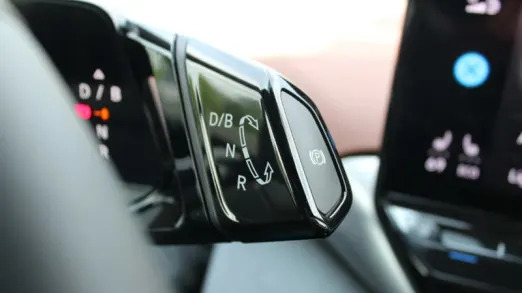
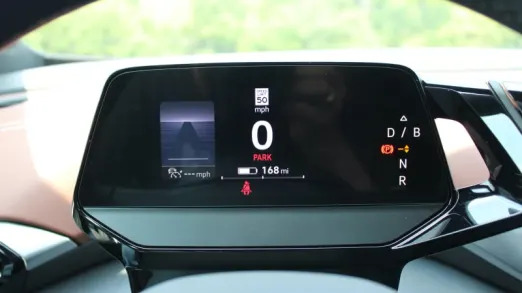
What are the ID.4 interior and in-car technology like?
The ID.4’s interior and in-car technology are the most avant-garde aspects of the entire car — for better and worse. The style is futuristic, with capacitive-touch switches, a dearth of physical knobs and buttons, and (on the 1st Edition) lots of gloss-white plastic — that’s replaced with more conventional-looking gloss black on the other trims. Behind the steering wheel is a small digital instrument cluster that’s mounted to the steering column not the dash. Sprouting to its right is a trapezoidal-shaped knob that’s the gear selector; twist one way for Drive, the other for Reverse. Push a button at the end for Park. Like other electric cars, there's no start or stop button.
Unfortunately, in its effort to make the interior look futuristic, Volkswagen made it difficult for those of us still used to the way things work in 2021. This isn't the first car with capacitive touch-sensitive controls and it also isn't the first to make them tolerable. Buttons and knobs are better. Even formerly simple operations like operating electric windows or adjusting the side mirrors have a new layer of complication. A regular driver likely would learn the ID.4’s quirks, but there’s really no benefit to any of this nonsense.
Then there's the central touchscreen, available in 10- or 12-inch sizes with broadly the same user interface. The graphics are slick and colorful, looking every bit as futuristic as is expected for an EV and in keeping with the interior's overall vibe. There's also no shortage of features, including Apple CarPlay and Android Auto. We found the complicated stuff worked well enough. Something simple like changing a radio station? Good luck. Radio presets, be it for terrestrial or Sirius satellite (pictured below left), are convoluted to select and to program, and seemingly cannot be displayed at the same time as the radio info (a big deal for satellite). We constantly drive new cars with different radio interfaces and this is easily the most frustrating we've come across in many years, both in terms of learning and using thereafter. While many and perhaps most drivers play music in some way through their phones these days, radio is still a thing, and there's no excuse for this nonsense.

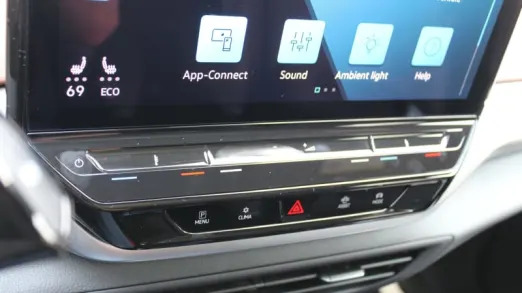
How big is the ID.4?
If you look at the specs, you'll see the VW ID.4 is right in the middle of the compact crossover bunch. However, its electric architecture makes it a Granny Smith in a basket of Galas. Yes, it's not as long as a Honda CR-V or Toyota RAV4, for instance, but its wheelbase is considerably longer. That's best seen in the truly gigantic back seat. We were able to fit an enormous rear-facing Britax Boulevard child seat behind both the passenger and driver seat set for a 6-foot-3 driver. That means you can fit two rear-facing car seats in the back seat, a rarity, while also equating to palatial legroom for big kids and adults. Heck, go ahead and bring along a few basketball players.
Their stuff won't be as well accommodated, though. Here's where the specs are indicative of the compact crossover segment. The 30.3 cubic feet of luggage space behind the rear seats and 64.2 cubic feet with the rear seatbacks folded again is indeed considerably less on paper and in person than what you'd find in a Honda CR-V (39.2/75.8) and Toyota RAV-4 (37.6/69.8). It's roughly similar to what you'd find in smaller entries like the Mazda CX-5.
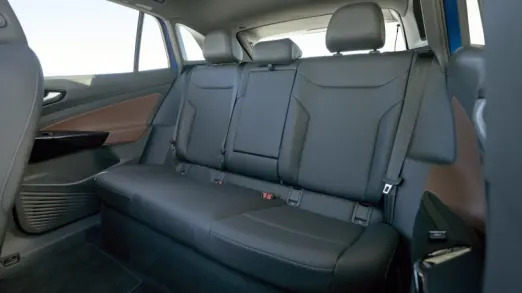

What are the ID.4’s range and performance specs?
The ID.4 offers a choice of rear-wheel-drive or all-wheel-drive models. Because the latter is achieved by adding a second motor to the front axle, that means that each drivetrain has a different power output. Both have the same 82-kilowatt-hour battery pack. Unlike some competitors, there is no option to upgrade to a larger battery pack with a longer range.
The rear-wheel-drive ID.4 has 201 horsepower and 229 pound-feet of torque. Expect a 0-60 time in the mid-8-second range, which is a bit slow for a compact crossover. EPA-estimated range is 260 miles for the base Pro and 250 miles for the Pro S. This is likely due to a difference in tires. In real-world testing of a Pro S, we saw range well in excess of its EPA-estimated 250 miles.
The ID.4 AWD has 295 horsepower. VW has not published a total torque figure at the time of this writing. Its 0-60 time plummets down to 5.7 seconds, which is blisteringly quick for a compact crossover. What a difference a second motor makes. At the same time, range doesn't take that much of a hit as the AWD Pro will go 249 miles and the AWD Pro S will go 240 miles.
One advantage for the ID.4 is that buyers get three years of free charging at the Electrify America network of EV chargers (a Volkswagen-owned outfit, which was part of its penance for VW's diesel emissions cheating). Recharging would take about 7.5 hours with a Level 2 charger, while VW says an ultra-powerful 125-kW public charger can take the battery pack from 5% to 80% charged in just under 40 minutes.

What's the ID.4 like to drive?
Volkswagen's performance bullseye with the ID.4 was compact SUVs rather than neck-snapping, high-performance EVs. You still get the immediate, smooth and utterly quiet power delivery of an EV, which makes it feel far more potent in around-town driving than the Honda CR-V's of this world. But should you merge onto the highway, you'll find the limitations of its horsepower result in ultimate acceleration that's best described as "sufficient." You know, like most of the other compact SUVs.
As for its ride and handling, the ID.4 quite clearly sprouted from the European branch of the Volkswagen family tree that spawned the Golf rather than the American one featuring bigger, cushier cars like the Passat and Tiguan. The ride is firmer and more controlled, and the steering more immediate and connected in its responses (though still awfully numb). When combined with its ultra-low center of gravity and rear-wheel-drive architecture, it all amounts to a surprisingly fun crossover to drive. We actually enjoyed flinging it around a mountain more than the Mustang Mach-E, a result that was just as surprising to us.
That said, the ride does let you feel more impacts from poor pavements, so some may lament the ID.4's European feel. There's also quite a lot of road noise, and despite the brake pedal having a natural feel to it, we wish we didn't have to use it so much. The ID.4 doesn't provide a heavy regenerative braking mode that allows for so-called one-pedal driving. It does have "B" mode that results in braking when you lift off the throttle, but the amount is comparable to the "low" modes of other EVs.
What other Volkswagen ID.4 reviews can I read?
2021 Volkswagen ID.4 vs 2021 Ford Mustang Mach-E Comparison Test
We put the two long-range, rear-wheel-drive EVs head to head. The results were surprising, with certain conclusions being the opposite of what we would've expected. For instance, we had more fun driving the Volkswagen, but the Ford had the nicer interior.
2021 VW ID.4 First Drive Review
In our first drive of the ID.4 we find that VW's mainstream approach seems right, but wondering it might result in it blending into the background of both the compact SUV and EV markets.
Volkswagen ID.4 Luggage Test
Officially, the ID.4 cargo capacity numbers are listed at 30.3 cubic-feet with the back seat raised and 64.2 cubic-feet when lowered. To put that into context, we load our standard assortment of luggage to see how the ID.4's cargo area compares to other compact SUVs.
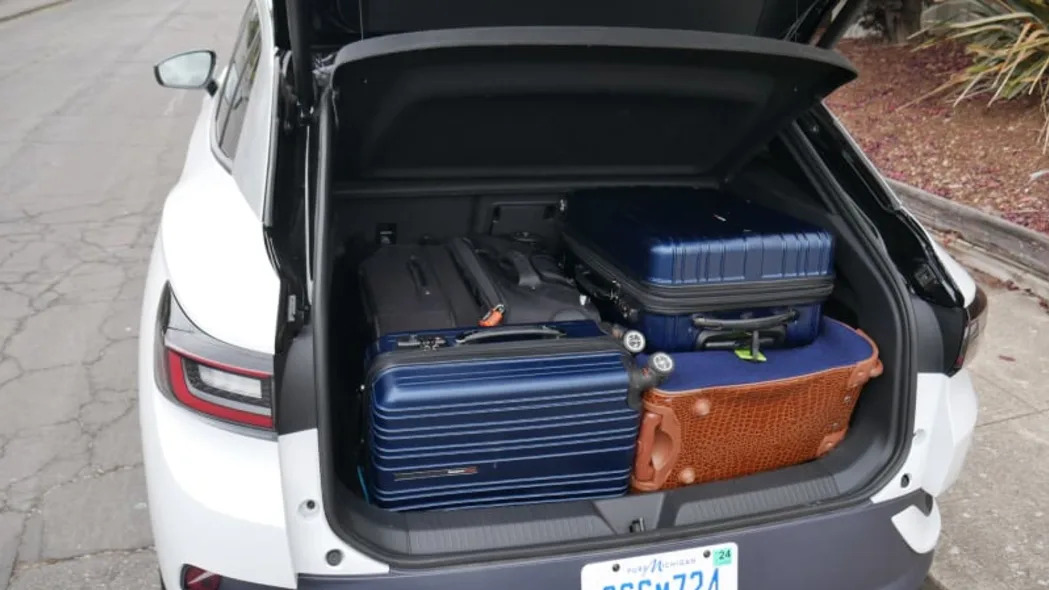
How much is the 2021 Volkswagen ID.4 price and what features are available?
The ID.4 is offered in Pro and Pro S trim levels, both of which offer rear-wheel or dual-motor all-wheel-drive powertrains. The Pro is $41,190 (including the $1,195 destination fee), and the Pro S is $45,690. The dual-motor AWD versions add $3,680 to those prices, which is steep for an all-wheel-drive system, but remember that you also get a lot more power. It's as much a performance upgrade as it is an all-weather one. Prices are also before the $7,500 federal tax credit, which is still in effect for Volkswagen (whereas it has expired for Tesla and GM).
The base Pro includes 19-inch wheels, dual-zone automatic climate control, six-way power seats, cloth upholstery, heated front seats and steering wheel, a digital instrument cluster, a 10-inch touchscreen, wireless device charging, four USB ports, in-car WiFi, Apple CarPlay, Android Auto, and natural voice controls.
The Pro S adds the larger touchscreen, leatherette seating surfaces, eight-way power seats with memory and massaging lumbar, a rear-seat center armrest and pass-through, a height-adjustable rear load floor, a hands-free power liftgate, a panoramic glass roof, adaptive headlights, power-folding mirrors with memory and puddle lights, and a light-up VW grille logo. There’s only one option available: The Gradient Package can be added to the Pro S, and includes 20-inch wheels, silver accents on the C-pillars, silver roof rails, and a black roof for $1,500.
Unlike some EVs, the ID.4 is available in all 50 states.
What are the VW ID.4 safety ratings and driver assistance features?
The Insurance Institute for Highway Safety (IIHS) and the National Highway Traffic Safety Administration (NHTSA) have yet to release safety ratings for the 2021 Volkswagen ID.4.
The model has a full complement of standard active-safety features. Those include forward-collision warning with pedestrian detection and automatic emergency braking, adaptive cruise control with stop-and-go capability, lane-keeping assist, blind-spot monitoring, rear cross-traffic alert, road-sign recognition and parking sensors.
Related Video:
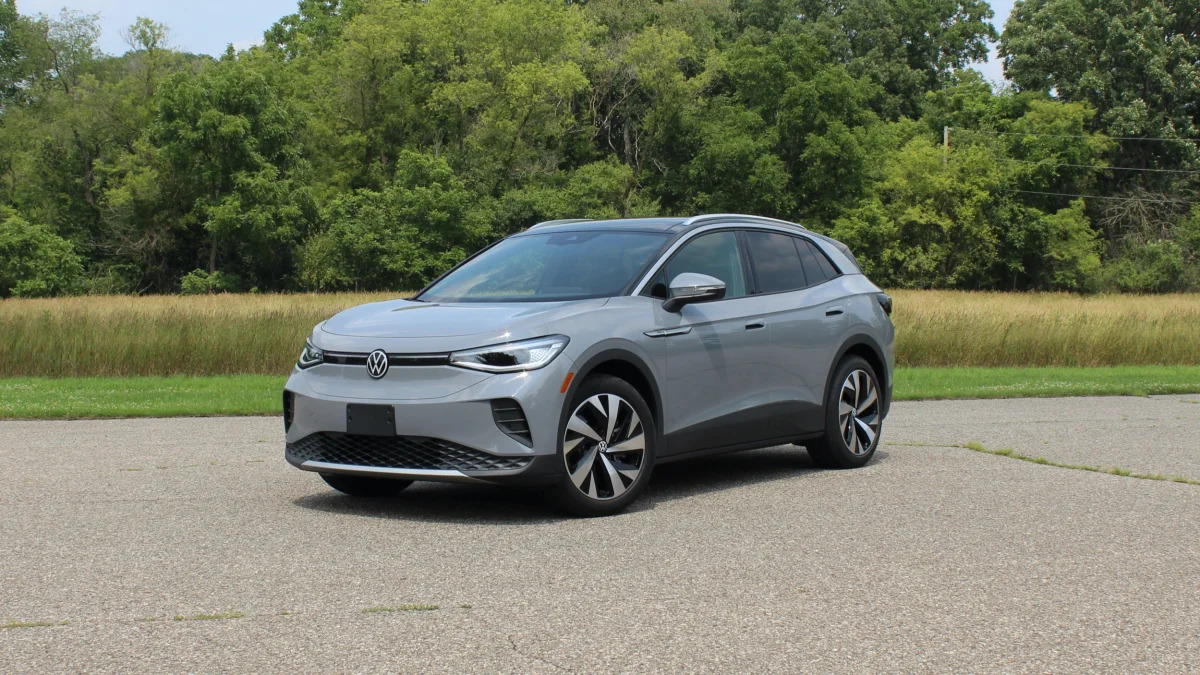

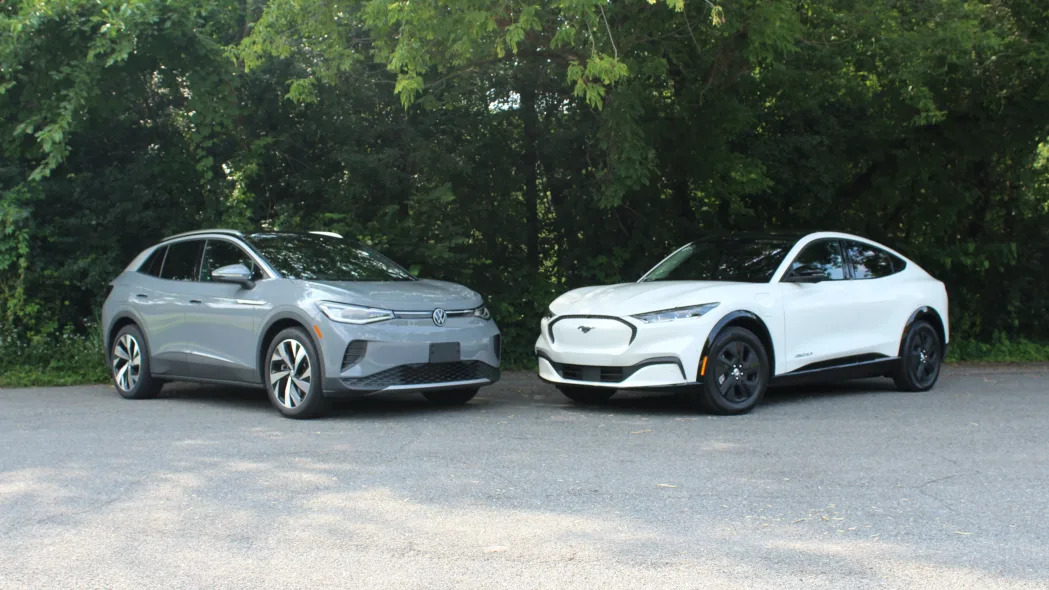
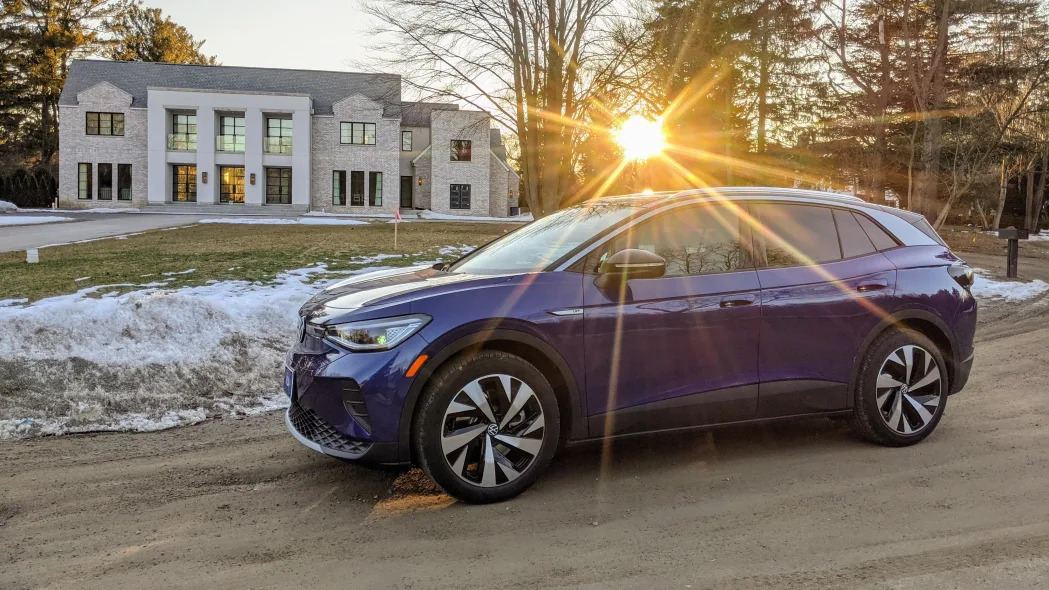









Sign in to post
Please sign in to leave a comment.
Continue